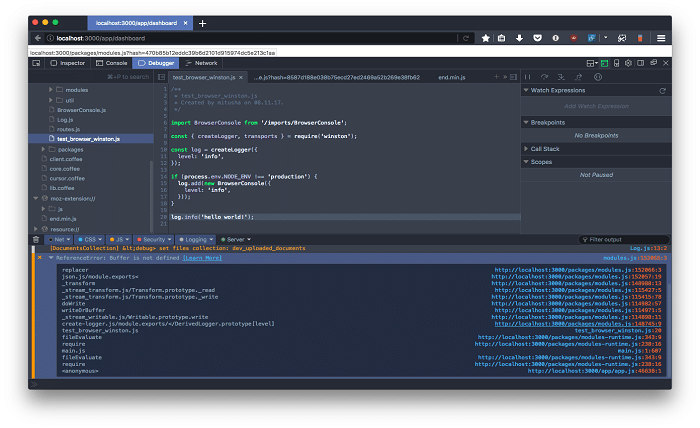Winston Logger: Features, Benefits, and Best Practices

Introduction
Winston Logger is a versatile and popular logging library used primarily in Node.js applications. It provides developers with a robust solution for managing and recording log data, which is crucial for debugging, monitoring, and maintaining applications. Whether you’re a seasoned developer or new to the world of Node.js, understanding how Winston Logger works can significantly improve your application’s reliability and performance. In this comprehensive guide, we’ll explore the ins and outs of Winston Logger, its features, and how to implement it effectively in your projects.
What is Winston Logger?
Winston Logger is an open-source, multi-transport logging library designed for Node.js. It allows developers to create custom loggers that can write to various output sources, known as transports, such as files, databases, or the console. The flexibility and configurability of Winston Logger make it a preferred choice for developers who need to implement sophisticated logging mechanisms in their applications. The primary goal of Winston Logger is to provide a simple yet powerful tool for managing logs, making it easier to track and troubleshoot issues in real-time.
Key Features of Winston Logger
One of the reasons Winston Logger stands out among other logging libraries is its rich feature set. Winston Logger offers a variety of features that cater to different logging needs. These include multiple transport support, custom log levels, formatters, and profiling capabilities. By using Winston Logger, developers can define custom log levels that suit their application’s specific requirements, enabling more granular control over log output. Additionally, Winston Logger’s support for multiple transports means that logs can be directed to various destinations simultaneously, ensuring that critical information is captured and stored effectively.
Installing and Setting Up Winston Logger
Getting started with Winston Logger is straightforward. To install Winston Logger, you can use npm, the Node.js package manager. The installation process is quick, and once completed, you can immediately begin configuring Winston Logger for your application. In this section, we’ll walk through the steps required to install Winston Logger and set up a basic logger. By the end of this section, you’ll have a functional Winston Logger instance ready to capture and manage log data in your Node.js application.
Configuring Transports in Winston Logger
One of the most powerful aspects of Winston Logger is its support for multiple transports. Transports in Winston Logger are essentially output channels where log data is sent. These can include files, databases, HTTP endpoints, and the console. Configuring transports in Winston Logger allows developers to control where and how log data is stored. For example, you might want to send error logs to a file while outputting debug information to the console. This section will cover how to configure various transports in Winston Logger, ensuring that your log data is organized and accessible.
Custom Log Levels in Winston Logger
Winston Logger provides a flexible system for defining custom log levels. Log levels are used to categorize log messages based on their severity or importance. In Winston Logger, you can define your own log levels to match the needs of your application. This feature is particularly useful for large-scale applications where different components may require different logging strategies. By setting custom log levels, you can ensure that the most critical information is logged and monitored closely. In this section, we’ll explore how to create and use custom log levels in Winston Logger.
Formatting Log Output in Winston Logger
Formatting log output is an essential part of logging, as it makes the log data more readable and easier to analyze. Winston Logger provides various formatting options that allow developers to customize the appearance of their logs. Whether you need simple text formatting or more complex JSON structures, Winston Logger has you covered. This section will delve into the different formatting options available in Winston Logger, including built-in formatters and how to create custom formats to meet your application’s needs.
Error Handling and Logging with Winston Logger
Effective error handling is a critical aspect of any application, and Winston Logger excels in this area. By integrating Winston Logger into your error-handling processes, you can capture detailed information about errors as they occur. This data can then be used to diagnose issues and improve application stability. Winston Logger allows you to log errors with custom messages, stack traces, and additional context, making it easier to pinpoint the root cause of a problem. In this section, we’ll discuss best practices for error handling and logging with Winston Logger.
Integrating Winston Logger with Express.js
Express.js is a popular web framework for Node.js, and Winston Logger integrates seamlessly with it. By using Winston Logger in an Express.js application, you can log HTTP requests, responses, and errors in a structured and consistent manner. This integration enhances the observability of your web application, making it easier to monitor performance and troubleshoot issues. In this section, we’ll guide you through the process of integrating Winston Logger with Express.js, covering common use cases and configuration options.
Profiling and Performance Monitoring with Winston Logger
Winston Logger is not just for logging errors and messages; it can also be used for profiling and performance monitoring. By leveraging Winston Logger’s profiling capabilities, you can measure the time it takes for specific functions or processes to execute. This information is valuable for optimizing your application and identifying performance bottlenecks. In this section, we’ll explore how to use Winston Logger for profiling and performance monitoring, ensuring that your application runs smoothly and efficiently.
Best Practices for Using Winston Logger
To get the most out of Winston Logger, it’s essential to follow best practices in logging. This includes organizing your logs, using appropriate log levels, and ensuring that log data is secure and accessible. In this section, we’ll cover a range of best practices for using Winston Logger effectively. By following these guidelines, you can create a robust logging strategy that enhances the reliability and maintainability of your application.
Common Issues and Troubleshooting with Winston Logger
While Winston Logger is a powerful tool, developers may encounter issues during implementation or usage. This section will address some common problems that users might face when working with Winston Logger, such as configuration errors, performance issues, or unexpected behavior. We’ll also provide troubleshooting tips and solutions to help you resolve these issues quickly and efficiently. By understanding these potential pitfalls, you can ensure a smooth experience with Winston Logger.
Conclusion
Winston Logger is a vital tool for any Node.js developer looking to implement a robust logging solution. With its extensive features, flexible configuration options, and ease of use, Winston Logger can significantly enhance the way you manage and analyze log data in your applications. Whether you’re building a simple web application or a complex distributed system, Winston Logger provides the tools you need to maintain high visibility and control over your application’s behavior. By following the guidelines and best practices outlined in this guide, you can optimize your logging strategy and ensure that your application remains reliable and efficient.
FAQs
1. What is Winston Logger used for?
Winston Logger is used for logging messages, errors, and other data in Node.js applications. It provides a flexible and powerful logging solution with support for multiple output channels, custom log levels, and formatting options.
2. How do I install Winston Logger?
You can install Winston Logger using npm, the Node.js package manager. The command npm install winston will add Winston Logger to your project, allowing you to start using it for logging immediately.
3. Can I use Winston Logger with Express.js?
Yes, Winston Logger integrates seamlessly with Express.js. It can be used to log HTTP requests, responses, and errors, providing better observability and monitoring for your web application.
4. What are transports in Winston Logger?
Transports in Winston Logger are output channels where log data is sent. These can include files, databases, the console, or any other destination. You can configure multiple transports to manage log data effectively.
5. How can I customize log levels in Winston Logger?
Winston Logger allows you to define custom log levels based on your application’s needs. This feature enables you to categorize and manage log data with greater granularity and control.





